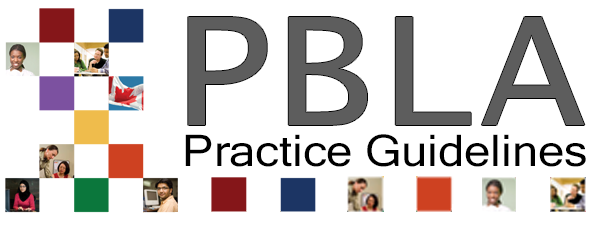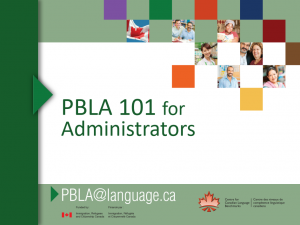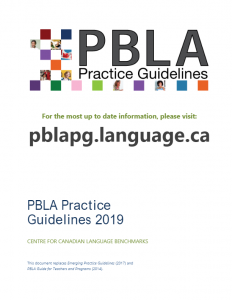PBLA Portfolios – Key Elements
Required Components of the PBLA Portfolio
Required Components of the PBLA Portfolio
The CLB standard and principles of assessment for learning together guide what is included in learner portfolios.
The needs assessment process helps to identify topics and social situations of relevance to the learner. Needs assessments may be done at different times during a course or term: at the beginning, to help plan a course, and/or prior to each module or topic, to help focus instruction and learning. Needs assessments are processes, not static documents; they should be reviewed periodically.
Sample needs assessments can be found in the supplementary document in the sidebar of this page, Portfolio Elements – Sample Forms .
| Sample needs assessments can also be found in the ESL for ALL Support Kit, Section V: ESL Literacy Resources (CCLB, 2015). |
Needs assessments are filed in the About Me section of My Portfolio.
Why do we include needs assessments? Like the CLB, PBLA is learner centred; a clear understanding of learner needs is essential for curriculum planning, goal setting, teaching, and assessment.
Goal setting helps learners identify their language goals. Like needs assessment, goal setting may be done at the beginning of the course or reporting period. Goals should be specific objectives that challenge the learner but are still achievable within the timeframe available. They will provide focus for the learner’s language learning and a reference for discussions about progress.
Shorter term goals are useful: a goal based on a module or on a week of study will help learners to see incremental improvements. One example can be found in the multilevel module (with teaching materials): At the Walk-in Clinic. Additional goal-setting examples can be found in the supplementary document, Portfolio Elements – Sample Forms.
For ESL literacy and beginning ESL learners, goal setting may be challenging; activities such as class goals or pictorial goal statements may help to introduce the concept and capture the intention.
| Samples for ESL Literacy can be found in the ESL for ALL Support Kit, Section V: ESL Literacy Resources (CCLB, 2015). |
Goal statements are stored in the About Me section of My Portfolio and should be reviewed during the course of study and also at the end of a reporting period.
Why do we include goals? Goal setting is rooted in the learner-centred nature of PBLA; the process engages learners in making decisions about their learning, reflecting the fundamental understanding that activating learners to become owners of their learning improves learning outcomes.
To clearly see their language development, learners and teachers need reference points for where they started.
At the outset of the class, learners should record their CLB levels (from their CLB placement assessment or from their previous class) in the portfolio. ESL Literacy and beginning ESL learners may find a graphic representation of their CLB levels easier to understand than a written form; a sample can be found in the supplementary document, Portfolio Elements – Sample Forms.
Initial CLB levels are recorded in the About Me section of My Portfolio.
Learning reflections consider the process of learning: what helps the learner learn. They focus on learners’ thinking about learning – and are not just descriptions of what was done in class. They should be incorporated as a regular part of the instructional cycle, for example at the end of a module.
Beginning ESL learners might find reflections challenging, so consider completing and posting learning reflections as a class. Learners can then copy them and add them to their portfolios.
Example: You might ask learners to choose one of the speaking strategies that was taught in class that week and reflect on their experience of using the strategy: When did they try the strategy? What happened? What might they do differently next time?
See the supplementary document, Portfolio Elements – Sample Forms for sample learning reflections.
| Samples for ESL Literacy can be found in the ESL for ALL Support Kit , Section V: ESL Literacy Resources (CCLB, 2015). |
Learning reflections are filed in the About Me section of My Portfolio.
Self-assessments consider what learners can do and how well they can do it related to task criteria. They help learners understand criteria and take responsibility for their own learning. Learners should have opportunities to self-assess on some (but not all) skill-using and assessment tasks.
Example: You might give learners the assessment tool before they complete a writing assessment task. They could then initial each of the criteria that they think they have met before handing in the task and assessment tool. When you provide feedback using the assessment tool, learners could compare it with their self-assessment.
See the supplementary document Portfolio Elements – Sample Forms for sample self-assessments.
| Samples for ESL Literacy can be found in the ESL for ALL Support Kit, Section V: ESL Literacy Resources (CCLB, 2015). |
Self-assessments and peer feedback, when used, are identified as such and attached to the associated artefact. They are not separate artefacts. Self-assessments are filed with the associated language task under the relevant skill in My Portfolio.
In the case of a speaking task, a self-assessment can be used together with other evidence as a single artefact. This evidence may include one or more of the following:
Why do we include reflections and self-assessments? Learners who understand language learning objectives and assessment criteria, and who have opportunities to think about their learning process, show greater progress than those who do not (McDonald & Boud, 2003; Davies, 2000).
To prepare learners for in-class real-world language tasks, teachers engage them in a variety of skill-building activities and skill-using tasks. Skill-building activities are designed to build the discrete prerequisite skills necessary for success on skill-using and assessment tasks. They focus on form and accuracy (e.g., in vocabulary, grammar and pronunciation exercises). While important for learning, they are not included in the learner portfolio. Instead, they may be filed in the My Notes section of My Portfolio.
Assessment tasks are often viewed as the most important artefacts in a portfolio. They focus on assessment of learning and provide a snapshot of achievement. However, skill-using tasks also play a vital role. They are the everyday classroom tasks in which learners have an opportunity to practise their skills and get feedback on their performance. They also provide evidence that helps a teacher identify growth over a reporting period, and as such are valuable artefacts in any review process.
| To review the steps in developing productive and receptive assessment tasks, including assessing different levels of comprehension, see the CCLB videos Developing a Receptive Skill Assessment Task and Developing a Productive Skills Assessment Task (CCLB, nd), and Integrating CLB Assessment (CCLB, 2016), Chapter 3, Developing Productive Skills Assessment Tasks and Chapter 4, Developing Receptive Skills Assessment Tasks. |
Skill-using and assessment artefacts are filed under the relevant skills in My Portfolio.
NOTE: If learners enter class with a portfolio and have not been assigned new benchmarks, they should keep all entries completed after the last benchmarks were assigned. These entries should be considered in the review at the end of the reporting period.
Why do we include both skill-using and assessment tasks? PBLA portfolios document growth and achievement. Together, skill-using and assessment tasks demonstrate what the learner can do, over time – helping learners see their progress and helping teachers make dependable judgements about what the learner can do in English.
Learners need to maintain a dated inventory for each skill (Listening, Speaking, Reading and Writing) in their portfolios, recording the skill-using and assessment tasks included and the competency areas addressed. Inventories help learners to keep track of the sequence and number of portfolio entries.
For examples, see the supplementary document in the sidebar of this page, Portfolio Skills Inventory Sheets.
Skills inventories are filed at the beginning of each of the four skills in My Portfolio.


